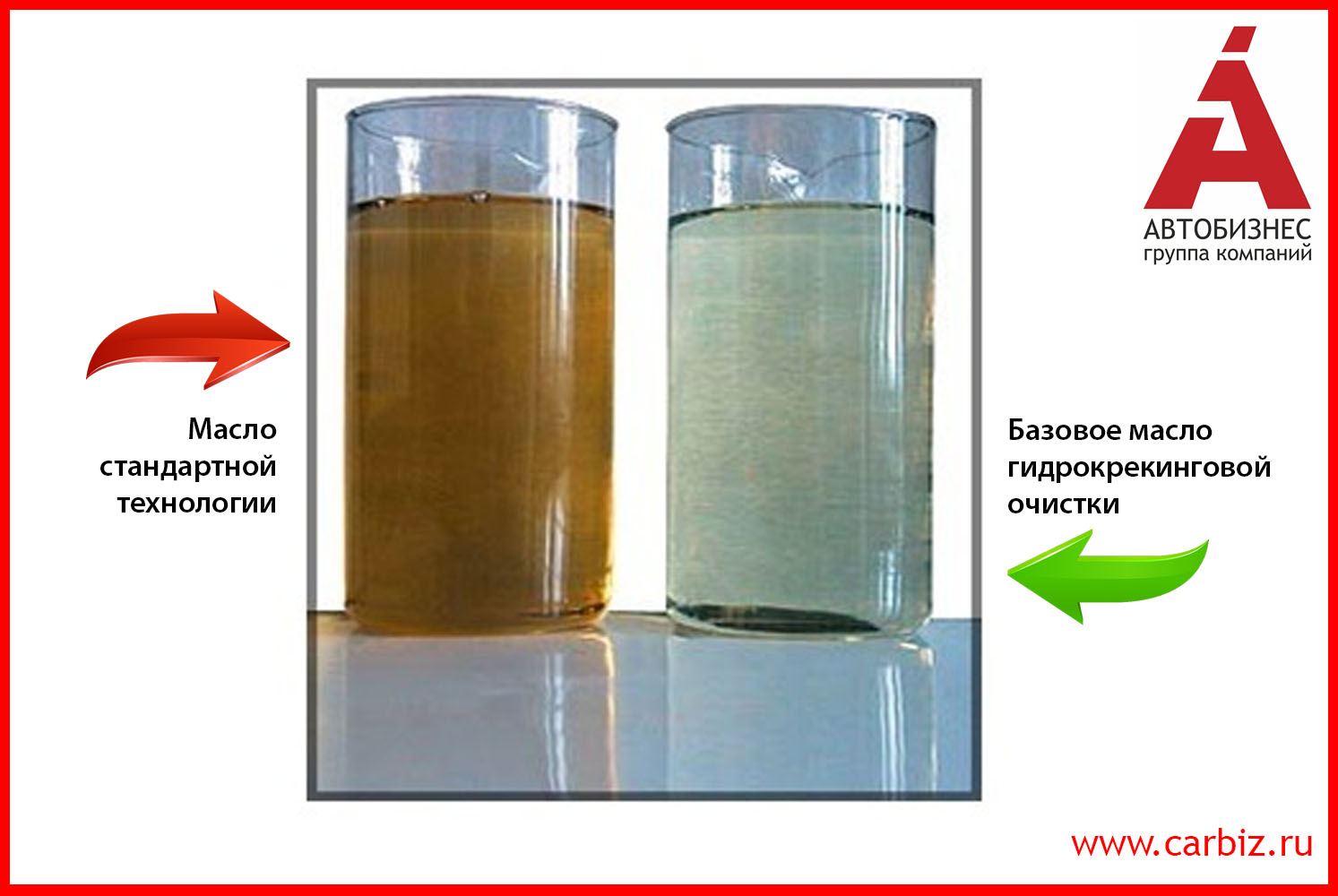
What is hydrocracked oil
Content
A novelty in the market of motor fluids - hydrocracking oil - received a mixed assessment among car owners. Some consider this lubricant the best modern development. Others pay attention to the features of the production of the material and speak negatively about it. Before drawing final conclusions, it is worth understanding hydrocracking oil - what it is, what are its advantages and disadvantages, and whether it is worth choosing lubricants of this quality for your own car.
Content
- 1 What is hydrocracked oil
- 1.1 Production technology
- 1.2 Basic properties
- 1.3 Advantages and disadvantages
- 2 HC or synthetic: what to choose and how to distinguish
- 2.1 Switching from synthetic to hydrocracked oil
- 2.2 How to distinguish hydrocracked oil from synthetic
- 2.2.1 Video: HC lubricants
What is hydrocracked oil
Hydrocracking is a process for refining base oils to produce base oils with high viscosity characteristics. The HC synthesis technology was developed by American chemists in the 1970s. During hydrocatalytic processing, "bad" oil fractions are converted into carbohydrates. The transformation of an ordinary “mineral water” into a “synthetics” of a higher quality occurs under the influence of chemical processes. On the one hand, HC-oil is produced from oil, like mineral oil, and on the other hand, the molecular structure of the base changes dramatically. The resulting composition completely loses the characteristics of mineral oil.

There are several types of hydrocracking
Production technology
To get a complete picture of the GK-oil will allow the study of production technology. Hydrocracking is a method of refining base mineral oil, which makes it possible to bring the characteristics of the final product closer to synthetics. The basis of the oil is oil, the molecular structure of which is changed using special chemical processes. Cleaning consists of three stages:
- Dewaxing. The removal of paraffins from oil contributes to an increase in the freezing point of the composition.
- Hydrotreating. At this stage, the hydrocarbon components are saturated with hydrogen and thus change their structure. The oil acquires resistance to oxidation processes.
- Hydrocracking is the removal of sulfur and nitrogen compounds. At this stage of purification, the rings are cleaved, bonds are saturated and paraffin chains are broken.
Three-stage purification allows you to rid the oil of unnecessary impurities and obtain an oil composition that differs from the usual mineral, synthetic or semi-synthetic ones. Therefore, manufacturers classify HC-oil as a separate category of lubricants.
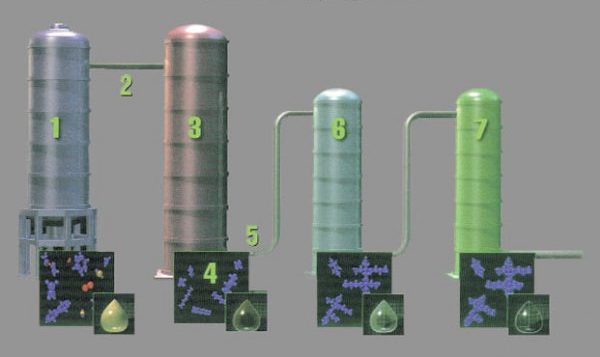
Hydrocracking technology
After the refining procedure, synthetic additives are introduced into the oil to give it the final properties and capabilities of high-quality lubricants.
Basic properties
The base of motor oils affects their viscosity. The thickest oils are mineral, the thinnest are synthetic. Hydrocracking oil, along with semi-synthetic, is in the middle position. The peculiarity of this lubricant is that in terms of production technology it is closer to mineral, and in terms of physical and chemical properties - to synthetic.

This type of oil has the properties of both mineral and synthetic oils.
The base created by hydrocracking technology has improved properties compared to the mineral one. In terms of purity, such oils are close to synthetic ones, but they have a much lower cost.
It is important! HC-synthesis makes it possible to obtain a lubricant with a viscosity index of 150 units, while mineral lubricants have a viscosity of only 100 units. The introduction of additives brings hydrocracking compositions as close as possible to synthetic ones.
Advantages and disadvantages
Multi-stage distillation of oil with subsequent enrichment with additives makes HA liquid a high-quality lubricating oil. The advantages of this lubricant are as follows:
- Efficient operation under mechanical or thermal overloads;
- Minimal aggressiveness to elastomers;
- Resistance to the formation of deposits;
- resistance to deformation;
- Optimum viscosity;
- Low coefficient of friction;
- High solubility of additives;
- Ecological compatibility.
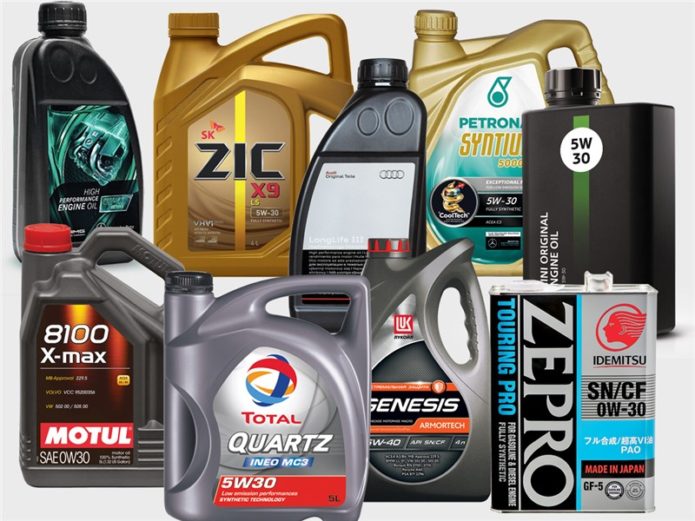
Hydrocracked oils have distinct advantages and disadvantages
With obvious advantages, this type of oil has a number of significant disadvantages:
- Increased evaporation;
- Tendency to provoke the formation of corrosion;
- Rapid aging and, as a result, the need for frequent replacement.
Despite some shortcomings, many car owners speak quite positively about its use. In terms of quality, it is slightly inferior only to high-class synthetic oils with the maximum cost. The advantage over synthetics of similar characteristics is a much lower price.
HC or synthetic: what to choose and how to distinguish
At the end of the chemical transformation of the HA base, its characteristics are significantly ahead of mineral oil, but it does not reach the level of high-quality "synthetics". The main idea of the developers of the new oil is proximity to synthetic varieties while reducing production costs. Theoretically, strict perfect observance of all technological processes can guarantee the receipt of a product that practically does not differ from synthetic. However, such complexity will immediately affect the price, so the goal is unlikely to be justified. Therefore, manufacturers prefer the “golden mean”: there are no properties of mineral lubricants in the new product, but it is not yet synthetic.
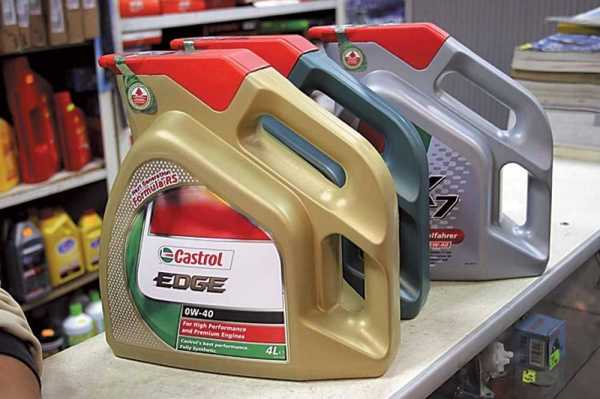
The choice of oil should be based on the needs of the car engine
But the chemical industry cannot yet offer anything ideal to car owners. Synthetics and hydrocracking have their advantages and disadvantages:
- Synthetic oil withstands incredible overloads, high speeds, ingress into the fuel composition without compromising quality. "Synthetics" works twice as long as HA and withstands overheating.
- However, in terms of stability during temperature changes, hydrocracking has a clear advantage. This product retains viscosity at both high and abnormally low temperatures. Therefore, it can be safely used in winter and summer. It is enough just to change or add lubricant more often than "synthetics".
- When using GK-oil, the parameters of starting the engine and the characteristics of its power are improved. The product has better lubricating properties compared to "synthetics". however, the declared properties of the additives lose quickly enough, and the lubricant ages.
It is important! When choosing a lubricant for the engine, you should focus on the characteristics of the car motor indicated in the instruction manual. It is necessary to take into account the operating conditions of the vehicle: in some regions, road conditions affect the rate of oil clogging, so it is not advisable to purchase an expensive product for long-term use.
Switching from synthetic to hydrocracked oil
The technology of the procedure for switching from synthetic to hydrocracked oil depends on the age and condition of the engine. On an old car, after draining, it is better to remove the pan and remove all the dirt and soot, which no amount of flushing helps get rid of.
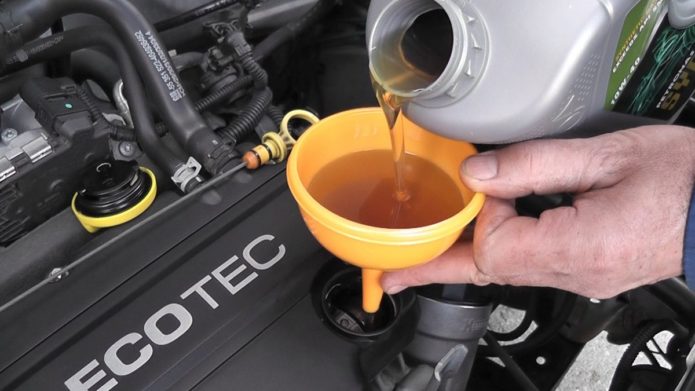
The procedure for changing the oil is simple and within the power of any car owner
In relatively new cars, it is enough to make a double oil change. After draining the synthetics, they fill in hydrocracking and drive 200–300 km. Then this portion of the oil is drained and a new one is poured.
It is important! Many experts believe that when switching from an oil of a higher class to a lower one, a simple change is sufficient, without flushing and refilling.
How to distinguish hydrocracked oil from synthetic
If the car owner opted for hydrocracking oil, he may have some difficulty in identifying it. The only guideline for most inexperienced consumers is the corresponding inscription on the package. Some manufacturers designate hydrocracking with the Latin abbreviation HC. But often there is no such identification mark on the package, so the consumer should get acquainted with the distinctive features of the product:
- Cost. The production cost of the HA product is much less than the "synthetics", so the price of the final product is much lower. At the same time, this oil is several times more expensive than mineral oil.
- Characteristics that are vague in meaning. The American Petroleum Institute has equated hydrocracked oils with synthetic ones, so many manufacturers introduce some ambiguity into the designation of the product category: they do not label “100% Synthetic” on the label, but write about the use of “synthetic technologies”. If there is a similar wording on the bank, HC oil is in front of the buyer.

To distinguish hydrocracking oil from synthetic, you need to know some of the nuances
These indicators only indirectly indicate the basis used by the manufacturers. It is possible to really distinguish hydrocracking from synthetics only in the laboratory. But there are several obvious indicators that you should pay attention to when choosing a lubricant:
- The inscription "Vollsynthetisches" is sufficient when the lubricant is made in Germany: here the concept of synthetic oil is clearly defined at the legislative level;
- Oils marked 5W, 10W, 15W, 20W are most likely “hydrocracking” or “semi-synthetics”;
- ZIC oils and almost all original lubricants for Japanese cars are exclusively hydrocracked.
Video: HC lubricants
Due to the ratio of price and quality, hydrocracking oils are becoming increasingly popular. Experts predict that with the constant improvement of production technology, this type of lubricant can overtake “synthetics” in terms of frequency of use.
